Search results for "Mauri_Kunnas/2010/2010/10/riikka-pulkkinen-totta-true"
Minä, Mauri Kunnas [I, Mauri Kunnas]
4 March 2010 | Mini reviews, Reviews
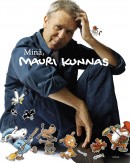 Minä, Mauri Kunnas
Minä, Mauri Kunnas
[I, Mauri Kunnas]
Muistiin merkitsi [As told to] Lotta Sonninen
Helsinki: Otava, 2009. 182 p., ill.
ISBN 978-951-1-23186-8
€ 40, hardback
Mauri Kunnas (born 1950) is a cartoonist and graphic artist. His children’s books have been translated into 28 languages; the translations have sold approximately 2,5 million copies. His anthropomorphic canine characters from Koiramäki, Doghill, are well known for their adventures in historical milieus; researching these settings is one of Kunnas’ passions. His reinterpretations of Finnish literary classics are also popular: The Canine Kalevala and Seven Dog Brothers offer affectionately humorous homages to the Kalevala, the Finnish folk epic, and the classic novel by Aleksis Kivi. Joulupukki (1981), published in English as Santa Claus, is arguably the world’s best-known Finnish children’s book. In this book, Kunnas gives a lively account of his childhood and youth, as well as his influences and the different phases of his career as an illustrator. The text is complemented by photos from Kunnas’ family album and his own archives, from adventure stories he illustrated as a boy to a pair of hippy bell-bottomed jeans adorned with doodles.
Riikka Pulkkinen: Totta [True]
22 October 2010 | Mini reviews, Reviews
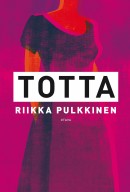 Totta
Totta
[True]
Helsinki: Otava, 2010. 333 p.
ISBN 978-951-1-22965-0
€ 31,40, hardback
The second novel by Riikka Pulkkinen (born 1980) is a comprehensive work that tackles big themes: love, death and rejection. Pulkkinen’s particular strengths as an author are her richly nuanced language and her mastery of structure. While the ending provides food for thought, the book is an enjoyable novel about childhood, growing up, daring to love and live. Martti, a seventy-year-old artist, is caring for his sick wife, a highly respected psychologist. Martti and Elsa have had a long and happy marriage. Then it emerges that Martti had a long affair with their live-in childminder Eeva, whose story grows into one of the main plot strands of the book. Their love story takes place against the background of the 1960s, when the waves passing through European society reached Finland as well. Pulkkinen skilfully brings the perspective of the now grown-up daughter Eleonoora into the mix, as she views her early childhood under the care of two mother figures. At the 2010 Frankfurt Book Fair translation rights to Totta were sold to six countries, which at least goes to show that there is interesting literature to be found in the Nordic countries beyond the ubiquitous crime novels.
Jonna Pulkkinen: Kieltolaki. Kielletyn viinan historia Suomessa. [Prohibition. A history of prohibited liquor in Finland.]
29 June 2015 | Mini reviews, Reviews
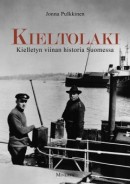 Jonna Pulkkinen
Jonna Pulkkinen
Kieltolaki. Kielletyn viinan historia Suomessa. [Prohibition. A history of prohibited liquor in Finland.]
Helsinki: Minerva, 2015. 213pp., ill.
ISBN 978-952-312-112-6
€32,90, hardback
Prohibition of the making and selling of strong liquor was in force in Finland between 1919 and 1932. In this approachable book, the journalist and non-fiction writer Jonna Pulkkinen charts Finnish attitudes to alcohol over the ages and describes the origin and effects of prohibition. Total abstinence was popular in Finland in the second half of the 19th century, and was adopted in particular by the working class. Limits on alcoholic consumption were first imposed as early as the First World War. When a prohibition law that had been passed a couple of years earlier came into effect in newly independent Finland in 1919, however, support had already begun to dwindle. Home stills proliferated, smuggling from abroad was considerable and broadly accepted, and enforcing the law was difficult. Pulkkinen has numerous interesting and even comical examples that flouted the law on prohibition. The law was broken in all social classes, the use of liquor and crime increased throughout the country, and taxation income on alcohol was lost. As public criticism grew, an advisory referendum was held in 1931, and as a result the prohibition law was abolished the following year.
And the winner is…?
27 March 2012 | This 'n' that
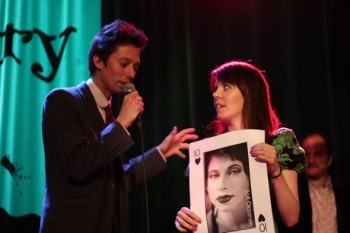
Playing your cards right: Todd Zuniga talks to Riikka Pulkkinen on 20 March in Helsinki. Photo: courtesy/T. Zuniga
The writer Johanna Sinisalo’s words lash the stage like the tail of Pessi the troll in her best-known novel. The novelist Riikka Pulkkinen bursts into deconstructive dance. The singer Anni Mattila translates the poet Teemu Manninen’s explosive poetic frolics into rhythmic dictations and the Finlandia Prize-winning author Rosa Liksom’s conductor’s glittering moustaches see the audience off on a train journey to Moscow.
On a March evening, a Literary Death Match has begun in the Korjaamo Culture Factory in Helsinki’s old tramsheds. The creation of the American author and journalist Todd Zuniga, the Literary Death Match combines an evening of readings with stand-up comedy as well as the judging familiar from reality TV shows.
‘It all started with me eating sushi with two of my friends and talking about some of the readings we’d been to. We all loved literature and loved to listen to writers reading from their own work. But the audience was always the same circle of people. We wanted to expand it beyond literary circles,’ Zuniga explains. More…
Tarmo Kunnas: Fasismin lumous. Eurooppalainen älymystö Mussolinin ja Hitlerin politiikan tukijana [The allure of fascism. European intellectuals as backers of the policies of Mussolini and Hitler]
13 March 2014 | Mini reviews, Reviews
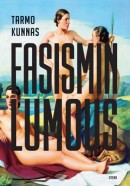 Fasismin lumous. Eurooppalainen älymystö Mussolinin ja Hitlerin politiikan tukijana
Fasismin lumous. Eurooppalainen älymystö Mussolinin ja Hitlerin politiikan tukijana
[The allure of fascism. European intellectuals as backers of the policies of Mussolini and Hitler]
Jyväskylä: Atena , 2013. 686 pp .
ISBN 978-951-796-933-8
€40, hardback
The most prominent fascist states in the period between the world wars were Nazi Germany and Mussolini’s Italy, but the ideology was reflected in the extremist movements of a number of European countries. The fascist movements could differ greatly, but their key feature was a strong nationalism that was both anti-democratic and anti-parliamentary. In his book, which at times is rather heavy going, Emeritus Professor Tarmo Kunnas examines the attraction of Fascist ideology for the European intelligentsia of the 1920s, 30s and 40s. He presents a nuanced view of the opinions of the period’s major intellectuals and detects the sources of their world outlook in factors like their philosophy of life. Their fascism rarely fitted in with party political programmes. Kunnas also sheds light on the fascist views of some of Finland’s cultural figures; according to him, in Finland genuine fascist groups did not really have much significance.
Translated by David McDuff
The books that sold
11 March 2011 | In the news

-Today we're off to the Middle Ages Fair. – Oh, right. - Welcome! I'm Knight Orgulf. – I'm a noblewoman. -Who are you? – The plague. *From Fingerpori by Pertti Jarla
Among the ten best-selling Finnish fiction books in 2010, according statistics compiled by the Booksellers’ Association of Finland, were three crime novels.
Number one on the list was the latest thriller by Ilkka Remes, Shokkiaalto (‘Shock wave‘, WSOY). It sold 72,600 copies. Second came a new family novel Totta (‘True’, Otava) by Riikka Pulkkinen, 59,100 copies.
Number three was a new thriller by Reijo Mäki (Kolmijalkainen mies, ‘The three-legged man’, Otava), and a new police novel by Matti Yrjänä Joensuu, Harjunpää ja rautahuone (‘Harjunpää and the iron room’, Otava), was number six.
The Finlandia Fiction Prize winner 2010, Nenäpäivä (‘Nose day’, Teos) by Mikko Rimminen, sold almost 54,000 copies and was fourth on the list. Sofi Oksanen’s record-breaking, prize-winning Puhdistus (Purge, WSOY; first published in 2008) was still in fifth place, with 52,000 copies sold.
Among translated fiction books were, as usual, names like Patricia Cornwell, Dan Brown and Liza Marklund.
In non-fiction, the weather, fickle and fierce, seems to be a subject of endless interest to Finns; the list was topped by Sääpäiväkirja 2011 (‘Weather book 2011’, Otava), with a whopping 140,000 copies. Number two was the Guinness World Records 2011, but with just 43,000 copies. Books on wine, cookery and garden were popular. A book on Finnish history after the civil war, Vihan ja rakkauden liekit (‘Flames of hate and love’, Otava) by Sirpa Kähkönen, made it to number 8 on the list.
The Finnish children’s books best-sellers’ list was topped by the latest picture book by Mauri Kunnas, Hurja-Harri ja pullon henki (‘Wild Harry and the genie’, Otava), selling almost 66,000 copies. As usual, Walt Disney ruled the roost in the translated fiction list.
The Finnish comics list was dominated by Pertti Jarla (his Fingerpori series books sold more than 70,000 copies, almost as much as Remes’ Shokkiaalto!) and Juba Tuomola (Viivi and Wagner series; both mostly published by Arktinen Banaani): between them, they grabbed 14 places out of 20!
It’s (virtually) Christmas!
28 November 2009 | This 'n' that
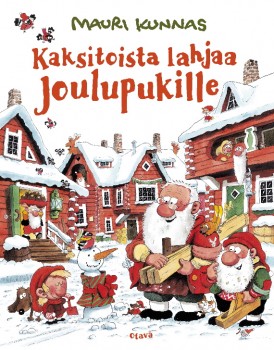
Father Christmas / Santa Claus by Mauri Kunnas
What to give the man who has everything? In prizewinning children’s author and illustrator Mauri Kunnas’s Twelve Gifts for Santa, Zac, one of Father Christmas’s little helpers, decides to give him twelve good deeds. Doing so is not as easy as it looks, however, and you can follow the twists and turns of the story on the Kidzone Finland advent calendar from Tuesday, 1 December, with one window opening each day until Christmas Eve.
Mauri Kunnas (born 1950) published the first of his popular picture books for children in 1980; entitled Koiramäen talossa (‘Doghill Farm’), it describes – with the accuracy of a treatise on folklore studies – life in a country farmhouse at the end of the 19th century. His hilarious canine characters, in more than forty books, have now found readers in almost thirty languages. More…
Best-selling books in September
18 October 2012 | In the news
Number one on the September list of best-selling Finnish fiction titles, compiled by the Finnish Booksellers’ Association, is Sofi Oksanen’s new novel Kun kyyhkyset katosivat (‘When the doves disappeared’, Like): which shot straight to the top of the list on its publication in August.
The huge national and international success of her previous novel, Puhdistus – in English, Purge – published in 2008 and also set in Estonia, has paved the way for Kun kyyhkyset katosivat; translation rights have been sold to several countries already.
Number two on the list was Riikka Pulkkinen’s third novel, Vieras (‘The stranger’, Otava). In third and fourth places were two new thrillers, Paholaisen pennut (‘The devil’s cubs’, Tammi), by Leena Lehtolainen, and Ylösnousemus (‘Resurrection’, WSOY), by Ilkka Remes.
In fifth place was Sirpa Kähkönen’s novel Hietakehto (‘Sand cradle’, Otava): number six in her series set in the Kuopio region of eastern Finland, during the Second World War.
The non-fiction (translated foreign as well as Finnish) list was topped by Blaine Harden’s Escape from Camp 14 (in North Korea; Gummerus). The variety of subjects on this list can be surprising: number two is about angels (Lorna Byrne’s A Message of Hope from the Angels, Otava), number three a biography of a Finnish ex-con turned surgeon (Veitsen terällä, ‘On knife’s edge’, by Arno Kotro & Christer Lybäck, Otava), number four about the Cold War in Finland (Jukka Tarkka: Karhun kainalossa, ‘Under the arm of the bear’, Otava) and number five about cupcakes (by Angela Drake, Otava)…
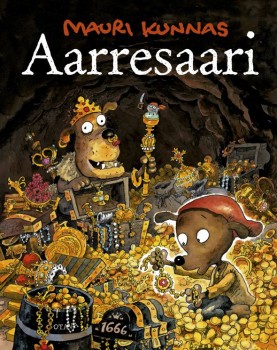
Mauri Kunnas: Aarresaari
The three best-selling children’s books were by seasoned Finnish authors: illustrator-writer Mauri Kunnas, with his tribute to R.L Stevenson, Aarresaari (‘Treasure island’, Otava), Aino Havukainen & Sami Toivonen, with Tatu ja Patu pihalla (‘Tatu and Patu outdoors’, Otava) and Sinikka Nopola & Tiina Nopola, with their Risto Räppääjä ja nukkavieru Nelli (‘Risto Rapper and Threadbare Nelly’, Tammi).
Riikka Pelo: Jokapäiväinen elämämme [Our everyday life]
13 June 2013 | Mini reviews, Reviews
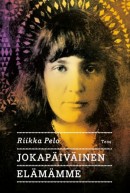 Jokapäiväinen elämämme
Jokapäiväinen elämämme
[Our everyday life]
Helsinki: Teos, 2013. 526 p.
ISBN 978-951-851-389-9
35.90€, hardback
At the centre of Riikka Pelo’s second novel are the Russian poet Marina Tsvetaeva (1892–1941) and her daughter Ariadna Efron (1912–1975). This broad historical novel depicts the mental landscape of Russia during the period between the two great wars, from the 1920s to the 1940s. The mother is a religious believer and idealist, her daughter a more pragmatic empiricist. The family’s fate is controlled by the Soviet state apparatus, which sends it into exile in Paris where Tsvetaeva’s husband Sergei Efron takes a job as a secret police informer in an organisation devoted to the repatriation of Soviet emigrés. In the 1930s they return to Moscow, where life under the watchful eye of Stalin is filled with difficulty and paranoia. Pelo portrays the awkward relationship between mother and daughter with particular vividness. The indisputable star of the family is the mother – her ambition extends to her daughter, who to her disappointment is more interested in the visual arts than in poetry. The historical characters of Pelo’s impressive novel live their contradictory lives in decades of social upheaval.
Translated by David McDuff
The books that sold
21 February 2013 | In the news
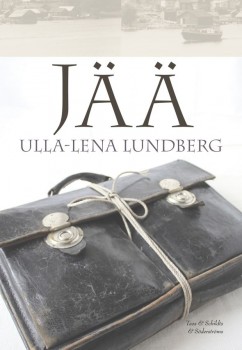 The winner of the Finlandia Prize for Fiction 2012, Ulla-Lena Lundberg’s novel Is (‘Ice’), also turned out to be the winner of the ‘Shadow Finlandia’ prize of the Academic Bookstore in Helsinki. The novel, set on the Åland islands in postwar years, was simultaneously published in Finnish as Jää. This book trade prize is awarded to the best-selling title of the six finalists on the Finlandia Prize list.
The winner of the Finlandia Prize for Fiction 2012, Ulla-Lena Lundberg’s novel Is (‘Ice’), also turned out to be the winner of the ‘Shadow Finlandia’ prize of the Academic Bookstore in Helsinki. The novel, set on the Åland islands in postwar years, was simultaneously published in Finnish as Jää. This book trade prize is awarded to the best-selling title of the six finalists on the Finlandia Prize list.
The best-selling Finnish debut work in the Academic Bookstore was Nälkävuosi (‘The hunger year’, Siltala) by Aki Ollikainen.
Also number one on the December list of best-selling Finnish fiction titles compiled by the Finnish Booksellers’ Association was Lundberg’s novel – in its Finnish translation; the original Swedish-language book came number ten on the same list.
Number two was Sofi Oksanen’s new novel set in Estonia, Kun kyyhkyset katosivat (‘When the doves disappeared’, Like), and number three the hilarious graphic story, Piitles. Tarina erään rockbändin alkutaipaleesta (‘Beatles. The story of the first stage of a rock band’, Otava), by Mauri Kunnas who has written and illustrated dozens of children’s books.
In first and second place on the translated fiction list were J.K. Rowling and J.R.R. Tolkien (The Casual Vacancy, The Hobbit or There and Back Again).
Children chose Finnish books in December – or rather their parents did, buying them as Christmas presents – for the first four places were taken by popular writers such as Sinikka and Tiina Nopola, Aino Havukainen & Sami Toivonen, Mauri Kunnas (Piitles is for mums and dads, not kids!) and Timo Parvela.
On the non-fiction list there was a selection of world record books, cookbooks and biographies – not unusual, considering the season – but number one was Kaiken käsikirja (‘Handbook of everything’) by astronomer and popular writer Esko Valtaoja. A present for all occasions, then?
Happy birthday to us!
13 February 2014 | Letter from the Editors

Picture: Wikipedia
It’s been five years since Books from Finland went online, and we’re celebrating with a little bit of good news.
In the past year, the number of visits to the Books from Finland website has grown by 11 per cent. The number of US and UK readers grew by 29 per cent, while the number of readers in Germany – stimulated perhaps by the publicity Finnish literature is attracting as a result of its Guest Country status at this year’s Frankfurt Book Fair – increased by an astonishing 59 per cent.
We’re chuffed, to put it mildly – and very thankful to you, dear readers, old and new. More…
Finland(ia) of the present day
2 December 2010 | In the news

Mikko Rimminen. Photo: Heini Lehväslaiho
The Finlandia Prize for Fiction 2010, worth €30,000, was awarded on 2 December to Mikko Rimminen (born 1975) ; his novel Nenäpäivä (‘Nose day’, Teos) was selected by the cultural journalist and editor Minna Joenniemi from a shortlist of six.
Appointed by the Finnish Book Foundation, the prize jury (Marianne Bargum, former publishing director of Söderströms, researcher and writer Lari Kotilainen and communications consultant Kirsi Piha) shortlisted the following novels:
Joel Haahtela: Katoamispiste (‘Vanishing point’, Otava), Markus Nummi: Karkkipäivä (‘Candy day’, Otava), Riikka Pulkkinen: Totta (‘True’, Teos), Mikko Rimminen: Nenäpäivä (‘Nose day’, Teos), Alexandra Salmela: 27 eli kuolema tekee taiteilijan (’27 or death makes an artist’, Teos) and Erik Wahlström: Flugtämjaren (in Finnish translation, Kärpäsenkesyttäjä, ‘The fly tamer’, Schildts). Here’s the FILI – Finnish Literature Exchange link to the jury’s comments.
Joenniemi noted the shortlisted books all involve problems experienced by people of different ages. How to be a consenting adult? How do adults listen to children? Contemporary society has been pushing the age limits of ‘youth’ upwards so that, for example, what used to be known as middle age now feels quite young. And, for example, in Erik Wahlström’s Flugtämjaren (now also on the shortlist for the Nordic Literature Prize 2011) the aged, paralysed 19th-century author J.L. Runeberg appears full of hatred: being revered as Finland’s national poet didn’t make him particularly noble-minded.
According to Joenniemi, Rimminen’s novel ‘takes a stand gently’ in its portrayal of contemporary life – in a city where a lonely person’s longing for human contacts takes on tragicomical proportions. Joenniemi finds Rimminen’s language ‘uniquely overflowing’. Its humour poses itself against the prevailing negative attitude, turning black into something lighter.
Rimminen has earlier published two collections of poems and two novels (Pussikaljaromaani, ‘Sixpack novel’, 2004, and Pölkky, ‘The log’, 2007) . Pussikaljaromaani has been translated into Dutch, German, Latvian, Russian and Swedish.


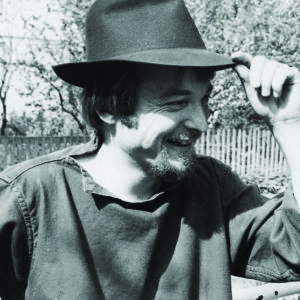
 Leena Kirstinä on the iconoclastic and pioneering poet – for children and adults –
Leena Kirstinä on the iconoclastic and pioneering poet – for children and adults –